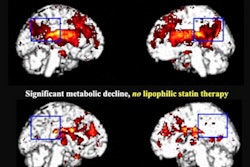
High levels of plaque calcification on coronary CT angiography (CCTA) scans were associated with a lower risk of acute coronary syndrome (ACS) and adverse cardiac events for individuals suspected of having heart disease in an international study published online January 22 in JAMA Cardiology.
Prior studies have associated high scores on CT coronary artery calcium (CAC) exams with increased risk of heart disease and adverse cardiac events. Yet stratifying this risk for distinct individuals remains a challenge. A team of researchers from eight different countries, led by Leslee Shaw, PhD, of Weill Cornell Medical College, set out to determine whether the degree of plaque calcification on CCTA scans could help.
For the Incident Coronary Syndromes Identified by Computed Tomography (ICONIC) study, Shaw and colleagues analyzed the coronary plaques of 378 individuals who underwent CCTA exams for suspicion of heart disease at 13 unique sites across the globe. Half of the cohort ended up developing acute coronary syndrome (ACS) within the roughly four-year follow-up period.
The researchers identified an inverse relationship between an individual's risk of ACS and the amount of highly calcified plaques (i.e., CT attenuation of more than 1,000 Hounsfield units) the individual's CCTA scans displayed. To be specific, individuals who developed ACS had an average of roughly 4 mm3 of highly calcified plaques, whereas those who did not develop heart disease had about 9.4 mm3 of highly calcified plaques.
| Association between acute coronary syndrome and plaque quality on CCTA | ||
| Mean volume per person | No acute coronary syndrome | Acute coronary syndrome |
| Total plaque | 252.9 mm3 | 258.9 mm3 |
| Calcified plaque | 99 mm3 | 76.4 mm3 |
| Highly calcified plaque (density > 1,000 Hounsfield units)* | 9.4 mm3 | 3.9 mm3 |
On a lesion-level analysis, they found that lesions responsible for ACS had a lower average volume of highly calcified plaques at 2.6 mm3 than did those without ACS at 7.6 mm3 (p < 0.001). Culprit lesions that led to heart attack also had a lower average volume of highly calcified plaques at 2 mm3, compared with 9.2 mm3 for the control (p = 0.02).
Though the presence of calcification on CCTA scans is not a reassuring sign per se, the results indicate that greater degrees of calcification in existing coronary plaques represent more stable atherosclerosis and a decreased likelihood of leading to adverse cardiac events, the authors wrote. The results also reflect the partially protective effect of high calcium density against coronary events and that it "may serve as a surrogate marker of risk for clinical outcomes in serial CCTA studies."
"The most striking result was the greater number of high-attenuation plaques in controls, plaques with more than 1,000 Hounsfield units ... [suggesting] that measurement of '1K plaque' may improve risk stratification beyond plaque burden," Dr. Michael Criqui from the University of California, San Diego and colleagues wrote in an invited commentary.
The improved understanding of the association between plaque calcium density and heart disease may have additional therapeutic implications, including emphasizing the value of statins in stabilizing plaques by increasing calcium density, they concluded.




















